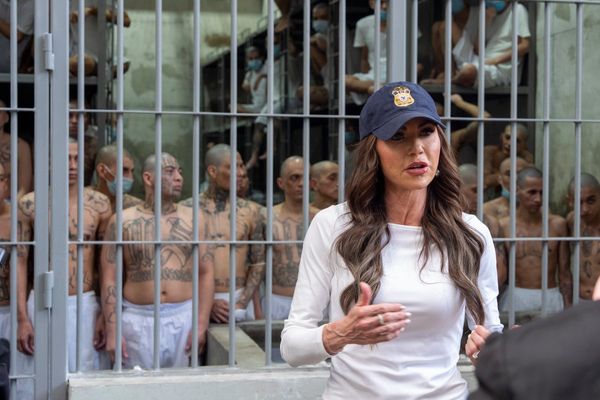Melburnians have a complicated relationship with the Yarra River, or the Birrarung as it is traditionally known.
It is often derided for being brown — although this is because of soil, rather than pollution — and plenty of locals couldn't say exactly where the river starts.
Most of us wouldn't swim in it, especially as it gets closer to the city, although some do.
Karin Traeger wants to change all that.
So, the chief executive of the non-profit Yarra Riverkeeper Association set out to be the first known person to run the whole length of the river, from its source to the sea.
The mammoth run took six days.
Immediately after finishing the run, standing on the sand in Port Melbourne, she told the ABC she did it to show people how special the river is.
"A lot of Victorians don't really recognise we have this amazing waterway on our doorstep," Ms Traeger said.
"It's the very same river at the top in Warburton — the very same river that's under the Princes Bridge."
Through mountains, mud and Melbourne, Ms Traeger learned a lot over six days.
It's a long and complicated run
The Birrarung/Yarra flows 242 kilometres from its source in the cool temperate rainforests of Mt Baw Baw, north-east of Melbourne, to Port Phillip, through Wurundjeri country.
However, parts of the river are not accessible, partly to protect the source of Melbourne's drinking water.
So Ms Traeger had to run around the river in sections, adding a lazy 40km to the journey.
All up, she ran 281km over six days.
Day one started near Cambarville, a former timber mill town in the Yarra Ranges National Park, surrounded by tall alpine ash and myrtle beech trees.
Ms Traeger said goodbye to her support crew in the dark, at 5am. She set off with a head torch and a hydration vest, packed with plenty of drinking water, a few 800-calorie dehydrated meals and a fully charged phone.
On her first day, she ran 70km — getting close to the distance of two full marathons.
Yarra an important source of drinking water
Day two involved a few river crossings — not over bridges, but through knee-deep water. There were steep hills and lots of mud.
In the upper reaches of the river, the water flows quickly, and it's not brown: Ms Traeger's blue running shoes were clearly visible through the water.
On day three, Ms Traeger met her support crew for a break at the Upper Yarra Reservoir, near Warburton.
The Yarra provides about 70 per cent of Melbourne's drinking water, and there's no access to the catchment for this area.
Its 90-metre high dam can hold up to 200,579 megalitres of water. Right now it's 85.6 per cent full.
The Yarra Riverkeeper, Charlotte Sterett, said that came after three years of La Niña and heavy rain. However, the dam will not always be that full.
"We're heading into a situation where we won't have enough water," Ms Sterett said.
"We'll have about a doubling of Melbourne's population in 40 years and the worst climate scenarios, which we're heading towards, means we're going to have about 40 per cent less water available."
"So is there going to be enough water for all of us? But, more importantly, is there going to be enough water for the environment? Because we can't have a healthy community without a healthy environment."
Concerns about water supply mean Ms Traeger has called for Victorians to consider other options, such as using more recycled and desalinated water.
There's plenty of litter and unwanted guests
Ms Traeger expected to find litter close to the city.
However, she was surprised to find polystyrene — which a report found is the most common plastic in the river — up near Warrandyte, 24km from the CBD.
"There was litter and polystyrene in Mt Lofty, which is [otherwise] quite pristine," she said.
"We found litter in very isolated places where you need a 4WD to access, basically, so that was a bit upsetting."
Ms Traeger and her crew collected about three bags full of rubbish along the way, and pulled out plenty of weeds.
"There were lots of invasive species, like blackberries, even footprints of deer," she said.
She said the highlight was running up Mt Donna Buang, in between Warburton and Healesville.
"You go through this amazing forest. You can see the climb. You can see the catchment area. It's just amazing," she said.
A long run builds a big hunger
The last day of her journey followed the river through the inner-Melbourne suburbs of Fairfield, Kew and Abbotsford, where more wildlife was seen than on any other day: a lizard, a snake and black cockatoos.
In the afternoon sun, Ms Traeger and her team passed through Federation Square and ran past the high-rises along Southbank to Docklands.
Ms Traeger jogged to the finish line about 5pm on day six, and was greeted by a sunset under the West Gate Bridge.
Her support crew and friends were there to greet her, with a camping chair, beer and chips.
So, how was she feeling when she crossed the finish line?
"Hungry!" she told the ABC.
She said she had "a few soft spots" in her legs, and was looking forward to a long ice bath and lots of massages on the weekend.
"I'm a bit in shock. I've never done anything like this," she said.
Ms Traeger is not the first person to track the Birrarung/Yarra River.
Author Maya Ward walked the length upstream in 21 days, and the river has played an important role for the Wurundjeri people for tens of thousands of years.
But this is the first known attempt to run the length of it, from source to sea.
"I'll probably get a bit emotional when I get home tonight," she said.
"I can't believe I did it!"







